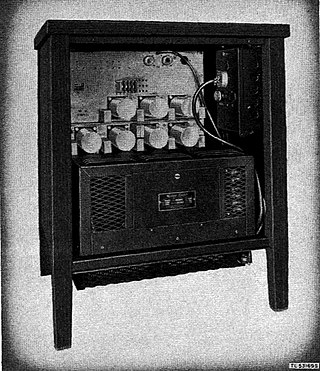Related Research Articles

Malware is any software intentionally designed to cause disruption to a computer, server, client, or computer network, leak private information, gain unauthorized access to information or systems, deprive access to information, or which unknowingly interferes with the user's computer security and privacy. Researchers tend to classify malware into one or more sub-types.
In computer security, a covert channel is a type of attack that creates a capability to transfer information objects between processes that are not supposed to be allowed to communicate by the computer security policy. The term, originated in 1973 by Butler Lampson, is defined as channels "not intended for information transfer at all, such as the service program's effect on system load," to distinguish it from legitimate channels that are subjected to access controls by COMPUSEC.

TEMPEST is a U.S. National Security Agency specification and a NATO certification referring to spying on information systems through leaking emanations, including unintentional radio or electrical signals, sounds, and vibrations. TEMPEST covers both methods to spy upon others and how to shield equipment against such spying. The protection efforts are also known as emission security (EMSEC), which is a subset of communications security (COMSEC).
End-to-end encryption (E2EE) is a system of communication where only the users communicating can read the messages. In principle, it prevents potential eavesdroppers – including telecom providers, Internet providers, malicious actors, and even the provider of the communication service – from being able to access the cryptographic keys needed to decrypt the conversation.

Cyberwarfare is the use of cyber attacks against an enemy state, causing comparable harm to actual warfare and/or disrupting vital computer systems. Some intended outcomes could be espionage, sabotage, propaganda, manipulation or economic warfare.
An air gap, air wall, air gapping or disconnected network is a network security measure employed on one or more computers to ensure that a secure computer network is physically isolated from unsecured networks, such as the public Internet or an unsecured local area network. It means a computer or network has no network interface controllers connected to other networks, with a physical or conceptual air gap, analogous to the air gap used in plumbing to maintain water quality.
The Advanced Learning and Research Institute (ALaRI), a faculty of informatics, was established in 1999 at the University of Lugano to promote research and education in embedded systems. The Faculty of Informatics within very few years has become one of the Switzerland major destinations for teaching and research, ranking third after the two Federal Institutes of Technology, Zurich and Lausanne.
Man-in-the-browser, a form of Internet threat related to man-in-the-middle (MITM), is a proxy Trojan horse that infects a web browser by taking advantage of vulnerabilities in browser security to modify web pages, modify transaction content or insert additional transactions, all in a covert fashion invisible to both the user and host web application. A MitB attack will be successful irrespective of whether security mechanisms such as SSL/PKI and/or two- or three-factor authentication solutions are in place. A MitB attack may be countered by using out-of-band transaction verification, although SMS verification can be defeated by man-in-the-mobile (MitMo) malware infection on the mobile phone. Trojans may be detected and removed by antivirus software;, but a 2011 report concluded that additional measures on top of antivirus software were needed.

Kaspersky Lab is a Russian multinational cybersecurity and anti-virus provider headquartered in Moscow, Russia, and operated by a holding company in the United Kingdom. It was founded in 1997 by Eugene Kaspersky, Natalya Kaspersky, and Alexey De-Monderik; Eugene Kaspersky is currently the CEO. Kaspersky Lab develops and sells antivirus, internet security, password management, endpoint security, and other cybersecurity products and services.
Cyber spying, cyber espionage, or cyber-collection is the act or practice of obtaining secrets and information without the permission and knowledge of the holder of the information using methods on the Internet, networks or individual computers through the use of proxy servers, cracking techniques and malicious software including Trojan horses and spyware. Cyber espionage can be used to target various actors- individuals, competitors, rivals, groups, governments, and others- in order to obtain personal, economic, political or military advantages. It may wholly be perpetrated online from computer desks of professionals on bases in far away countries or may involve infiltration at home by computer trained conventional spies and moles or in other cases may be the criminal handiwork of amateur malicious hackers and software programmers.
Stuxnet is a malicious computer worm first uncovered in 2010 and thought to have been in development since at least 2005. Stuxnet targets supervisory control and data acquisition (SCADA) systems and is believed to be responsible for causing substantial damage to the nuclear program of Iran. Although neither country has openly admitted responsibility, the worm is widely understood to be a cyberweapon built jointly by the United States and Israel in a collaborative effort known as Operation Olympic Games. The program, started during the Bush administration, was rapidly expanded within the first months of Barack Obama's presidency.
The term kill chain is a military concept which identifies the structure of an attack. It consists of:
The following outline is provided as an overview of and topical guide to computer security:

"Operation Newscaster", as labelled by American firm iSIGHT Partners in 2014, is a cyber espionage covert operation directed at military and political figures using social networking, allegedly done by Iran. The operation has been described as "creative", "long-term" and "unprecedented". According to iSIGHT Partners, it is "the most elaborate cyber espionage campaign using social engineering that has been uncovered to date from any nation".
Stegomalware is a type of malware that uses steganography to hinder detection. Steganography is the practice of concealing a file, message, image, or video within another file, message, image, video or network traffic. This type of malware operates by building a steganographic system to hide malicious data within its resources and then extracts and executes them dynamically. It is considered one of the most sophisticated and stealthy ways of obfuscation.

Vault 7 is a series of documents that WikiLeaks began to publish on 7 March 2017, detailing the activities and capabilities of the United States Central Intelligence Agency (CIA) to perform electronic surveillance and cyber warfare. The files, dating from 2013 to 2016, include details on the agency's software capabilities, such as the ability to compromise cars, smart TVs, web browsers, and the operating systems of most smartphones, as well as other operating systems such as Microsoft Windows, macOS, and Linux. A CIA internal audit identified 91 malware tools out of more than 500 tools in use in 2016 being compromised by the release. The tools were developed by the Operations Support Branch of the C.I.A.
PLATINUM is the name given by Microsoft to a cybercrime collective active against governments and related organizations in South and Southeast Asia. They are secretive and not much is known about the members of the group. The group's skill means that its attacks sometimes go without detection for many years.

Yuval Elovici is a computer scientist. He is a professor in the Department of Software and Information Systems Engineering at Ben-Gurion University of the Negev (BGU), where he is the incumbent of the Davide and Irene Sala Chair in Homeland Security Research. He is the director of the Cyber Security Research Center at BGU and the founder and director of the Telekom Innovation Laboratories at Ben-Gurion University. In addition to his roles at BGU, he also serves as the lab director of Singapore University of Technology and Design’s (SUTD) ST Electronics-SUTD Cyber Security Laboratory, as well as the research director of iTrust. In 2014 he co-founded Morphisec, a start-up company, that develops cyber security mechanisms related to moving target defense.
Data exfiltration occurs when malware and/or a malicious actor carries out an unauthorized data transfer from a computer. It is also commonly called data extrusion or data exportation. Data exfiltration is also considered a form of data theft. Since the year 2000, a number of data exfiltration efforts severely damaged the consumer confidence, corporate valuation, and intellectual property of businesses and national security of governments across the world.
Red Apollo is a Chinese state-sponsored cyberespionage group which has operated since 2006. In a 2018 indictment, the United States Department of Justice attributed the group to the Tianjin State Security Bureau of the Ministry of State Security.
References
- ↑ Carrara, Brent (September 2016). Air-Gap Covert Channels (PDF) (PhD). University of Ottawa.
- ↑ Carrara, Brent; Adams, Carlisle (2016-01-01). "A Survey and Taxonomy Aimed at the Detection and Measurement of Covert Channels". Proceedings of the 4th ACM Workshop on Information Hiding and Multimedia Security. IH&MMSec '16. New York, NY, USA: ACM: 115–126. doi:10.1145/2909827.2930800. ISBN 9781450342902. S2CID 34896818.
- ↑ Goodin, Dan (2 December 2013). "Scientist-developed malware prototype covertly jumps air gaps using inaudible sound". Ars Technica.
- ↑ Visu, Dr.P; Chakkaravarthy, S.Sibi; Kumar, K.A.Varun; Harish, A; Kanmani, S (October 2014). "Air-Gap Malware" (PDF). Computer Engineers Technical Association – News Letter. Vel Tech University (1): 2. Archived from the original (PDF) on 22 March 2015. Retrieved 21 March 2015.
- ↑ Guri, Mordechai; Kedma, Gabi; Kachlon, Assaf; Elovici, Yuval (November 2014). "AirHopper: Bridging the Air-Gap between Isolated Networks and Mobile Phones using Radio Frequencies". arXiv: 1411.0237 [cs.CR].
- ↑ Guri, Mordechai; Kedma, Gabi; Kachlon, Assaf; Elovici, Yuval (November 2014). "How to leak sensitive data from an isolated computer (air-gap) to a near by mobile phone - AirHopper". BGU Cyber Security Labs.
- ↑ Guri, Mordechai; Monitz, Matan; Mirski, Yisroel; Elovici, Yuval (April 2015). "BitWhisper: Covert Signaling Channel between Air-Gapped Computers using Thermal Manipulations". arXiv: 1503.07919 [cs.CR].
- ↑ Guri, Mordechai; Monitz, Matan; Mirski, Yisroel; Elovici, Yuval (March 2015). "BitWhisper: The Heat is on the Air-Gap". BGU Cyber Security Labs.
- ↑ Guri, Mordechai; Kachlon, Assaf; Hasson, Ofer; Kedma, Gabi; Mirsky, Yisroel; Elovici, Yuval (August 2015). "GSMem: Data Exfiltration from Air-Gapped Computers over GSM Frequencies". 24th USENIX Security Symposium (USENIX Security 15): 849–864. ISBN 9781939133113.
- ↑ Guri, Mordechai; Kachlon, Assaf; Hasson, Ofer; Kedma, Gabi; Mirsky, Yisroel; Monitz, Matan; Elovici, Yuval (July 2015). "GSMem Breaking The Air-Gap". Cyber Security Labs @ Ben Gurion University.
- ↑ Carrara, Brent; Adams, Carlisle (2016-06-01). "Out-of-Band Covert Channels—A Survey". ACM Comput. Surv. 49 (2): 23:1–23:36. doi:10.1145/2938370. ISSN 0360-0300. S2CID 13902799.